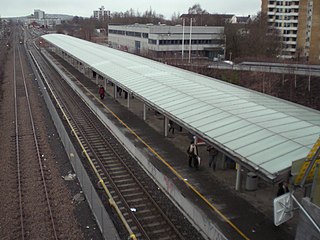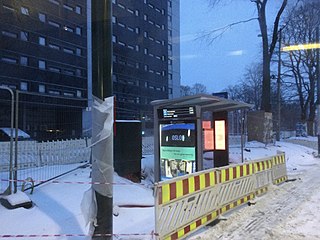The Oslo tram network is the tram system in Oslo, Norway. It consists of six lines with 99 stops and has a daily ridership of 132,000. It is operated by Sporveien Trikken AS, a subsidiary of the municipally-owned Sporveien who maintain the track and 72 tram vehicles on contracts with the public transport authority Ruter. The system operates on standard gauge and uses 750 V DC overhead. Depot, workshops and headquarters are at Grefsen. There is also a depot at Holtet that is home to the technical company InfraPartner, which maintains the track for the tram and metro systems in Oslo, and a small office building for Oslo Sporveier.

Stortinget is an underground rapid transit station on the Common Line of the Oslo Metro, Norway. It is located in the heart of the city center, next to the Parliament of Norway Building (Stortinget). The station is served by all of the five lines of the metro. At the street level, the station serves tram routes 11, 12, 13, 17, 18 and 19. Lines 11, 12 and 13 serves Øvre Slottsgate on the Vika Line while Lines 17, 18 and 19 stops at Tinghuset in the Ullevål Hageby Line. Also close to the station, there is a stop named Prof. Aschehougs gate that stops line FB5 to Oslo Airport, Gardermoen. Stortinget is 'kilometer marker zero' for the metro network and is owned by Sporveien T-banen.

Storo is a rapid transit station on the Ring Line of the Oslo Metro, and a tram station on the Grünerløkka–Torshov Line of the Oslo Tramway. It is located at Storo in the Nordre Aker borough of Oslo, Norway. The tram station opened on 28 November 1902, and the rapid transit station on 20 August 2003. Metro lines 4 and 5 run to the station. The tram station serves lines 11, 12 and 18. The station is within walking distance of Grefsen Station on the Gjøvik Line. The station also functions as a bus hub, being located along Ring 3. Storo is a mixed commercial and residential area, and a shopping center is located just north of the subway station.

Sinsen is a rapid transit station on the Ring Line of the Oslo Metro. It is located at Sinsen in the Sagene borough of Oslo, Norway. Next to the station is the tram station Sinsenkrysset, that has been part of the Sinsen Line of the Oslo Tramway since 1939. The station opened on 20 August 2006, as part of the first section of the Ring Line. The station is served by line 4 and 5 of the metro, as well as several local bus services. Sinsen is a mixed residential and commercial area.

AS Oslo Sporveier is a defunct municipal owned company responsible for public transport in Oslo, Norway. It was created in 1924 to take over the city's two private tram companies. In 1927 its started with bus transport, including from 1940 to 1968 trolleybuses. Since 1966 rapid transit and from 1985 water buses have also been operated by the company. It was split into two separate companies in 2006; Kollektivtransportproduksjon took over the operation while Oslo Public Transport Administration was responsible for buying the services, fare regulation and marketing. The latter merged into Ruter in 2008, when the Oslo Sporveier brand was discontinued.

Grefsen station is a railway station at Storo in Oslo, Norway on the Gjøvik Line. From the station there is also a short railway, the Alnabru–Grefsen Line, to Alna on the Hoved Line. The station is located 6.82 km from Oslo Central Station and is located between Tøyen and Nydalen at 109.2 metes above sea level. It was opened on 20 December 1900, two years before the railway to Gjøvik was finished.

Kjelsås Station is located at Kjelsås in Oslo, Norway on the Gjøvik Line. The railway station is located 10.28 km (6.39 mi) from Oslo Central Station between Nydalen Station and Snippen Station at 155.6 meters (510 ft) above sea level and was opened in 1900, two years before the railway to Gjøvik was finished.

The Sagene Line is a former line of the Oslo Tramway in Norway. It ran from Stortorvet in the city center along Akersgata and Ullevålsveien through the neighborhood of St. Hanshaugen. It then continued along Colletts gate, Geitmyrsveien and Kierschouws gate to Sagene. At Sagene Church it had a regulation stop and access to Sagene Depot. The line continued along Bentsebrugata to Torshov, where it intersected with the Grünerløkka–Torshov Line.

Ruter AS is the public transport authority for Oslo and Akershus counties in Norway. Formally a limited company – 60% of its shares are owned by the Oslo county municipality and 40% by that of Akershus – it is responsible for the administration, funding, and marketing of public transport in the two counties, including buses, the Oslo Metro, Oslo Trams, and ferry services. Ruter also holds agreements with Entur concerning the regulation of fares on local and regional train services operated within the two counties.
A/S Kristiania Sporveisselskab or KSS, nicknamed the Green Tramway, was an operator of part of the Oslo Tramway from 1875 to 1924. The company was established in 1874 and started with horsecar operations on the Ullevål Hageby Line, Gamlebyen Line and the Grünerløkka–Torshov Line. The network was electrified with in 1899 and 1900, whereby the company was bought by Union-Elektricitäts-Gesellschaft. It delivered new Class U trams. Within a few years the company had also opened the Vålerenga Line and Kampen Line. It took over Kristiania Kommunale Sporveie in 1905, taking over its fleet of Class S trams and the Sagene Ring, the Vippetangen Line and the Rodeløkka Line.

Kristiania Kommunale Sporveie or KKS, colloquially known as the Red Tramway was a municipal owned company that operated parts of the Oslo Tramway from 1899 to 1905. KKS built and operated three lines, Sagene Ring, the Rodeløkka Line and the Vippetangen Line. The three were connected by means of lines of Kristiania Sporveisselskab (KSS) and Kristiania Elektriske Sporvei (KES). KKS bought twenty motorized trams from Schuckert & Co. and twelve trailers, designated as Class S. It built two depots, Sagene and Rodeløkka.
The Grünerløkka–Torshov is a tramway line running between Jernbanetorget to Storo in Oslo, Norway. It is served by lines 11, 12 and 18 of the Oslo Tramway. The line serves the city-centre of Oslo, Grunerlokka and Sagene. The line is currently served by SL79, SL95 and SL18 trams.

The Sinsen Line is part of the Oslo Tramway on the east side of the city. Most of the line is served by line 17, although the northernmost tip (Grefsen–Torshov) is served by line 18 which otherwise runs on the Grünerløkka–Torshov Line. Both services use SL95 articulated trams.

The history of the Oslo Tramway and Oslo Metro in Oslo, Norway, starts in 1875, when Kristiania Sporveisselskab (KSS) opened two horsecar lines through the city centre. In 1894, Kristiania Elektriske Sporvei (KES) built the first electric street tramways, which ran west from the city centre. Within six years, all tramways were electric. The city council established Kristiania Kommunale Sporveie (KKS) in 1899, which built three lines before it was sold to KSS six years later. Both KSS and KES were taken over by the municipality in 1924, becoming Oslo Sporveier. The company gradually expanded the city tram network, which reached its peak length in 1939.

Biermanns gate is a tram stop on the Grünerløkka-Torshov Line of the Oslo Tramway. It is served by lines 11, 12 and 18. It was opened in 1990, but trams operated on the street of Vogts gate, which is where it is located today, since 1899. This was because the Grünerløkka–Torshov Line was extended up further to Torshov.

Nybrua is a tram station which was opened in February 2021. It is served by lines 11, 12, 17 and 18. It is located near where the old tram station, Hausmanns gate stood. It is located between Storgata (westbound) and Schous plass and Heimdalsgata. It is served with both SL79 and SL95 trams. SL18 trams also serve the station on routes 17 and 18.

Disen is a tram stop located on the Oslo Tramway network. Located in Nordre Aker in northern Oslo, the station is part of the Kjelsås Line, that operates between Storo and Kjelsås. Disen also has a balloon loop, for trams to turn around and change direction. However, trams do not regularly terminate at Disen anymore. Disen was opened on 25 September 1934. Disen was also closed along with the rest of the Kjelsås Line between 2002 and 2004. Uni-directional SL79 trams serve the tram stop, but occasionally SL95 trams serve Line 12.

The SL18(short for Sporvogn Ledd, commissioned in 2018) is a series of 87 low-floor, articulated trams currently being phased-in on the Oslo Tramway network. They will continue to be phased-in until 2025, when the last SL79s and SL95s are replaced. They were purchased from the Spanish tram manufacturer, CAF. The first one was shipped and unveiled at Grefsen depot in 2020, and regular operation begun in 2022. The entire purchase has a price of 4.2 billion krones. There is also a possibility of acquiring another 60 more trams from CAF.

Grefsen Depot is a tram depot located next to the Grefsen station tram stop. Grefsen Depot is one of the only tramway depots in Oslo, along with the Holtet depot, which is near the Holtet tram stop. The depot currently stores SL79, SL95 and SL18 trams after the daily operating period ends. The depot has also formerly stored the Høka, the SM90 and the SM91 rolling-stock. The entire depot takes up approximately 15, 000 square metres. The depot has an office for Sporveien Trikken, as well as an association office for Oslo Sporveiers Arbeiderforening's Streetcar Club.

Sandaker senter is a tram stop on the Grünerløkka–Torshov Line of the Oslo Tramway network. It is located in the borough of Sagene in Oslo, Norway. Sandaker senter is right next to the mall It is also located near Sagene Fire Station and a mill called Bjølsen Valsemølle. This mill was part of the former Grain Tram system, in which special trams transported grain from the silos at Vippetangen. They stopped transporting grain in 1967, after running for 49 years.




















